![]()
![]()
![]()
Use LEFT and RIGHT arrow keys to navigate between flashcards;
Use UP and DOWN arrow keys to flip the card;
H to show hint;
A reads text to speech;
87 Cards in this Set
- Front
- Back
|
Apoptosis |
Cell suicide pathway, initiated by cell when fault is detected (normally). |
|
|
Directly Ionizing Radiation
(examples of)
|
Charged particles (protons, electrons, alpha's etc) |
|
|
Indirectly Ionizing Radiation
(examples of) |
x-rays, gamma-rays, neutrons
(create fast moving charged secondary particles) |
|
|
3 effects of high energy (6-15MeV) beams |
-Compton scattering process dominates
-stopping potential largely independent of Z
-similar dose/g in tissue/bone/muscle |
|
|
Pair Production threshold energy and parent particles |
Threshold of 1.02MeV based on interaction between photon and nucleus |
|
|
High LET radiation |
direct action dominates
|
|
|
Low LET radiation |
indirect action dominates |
|
|
Hydroxyl Radical |
OH -contains 9 electrons (1 unpaired) -can diffuse short distances (~4nm) -~2/3 rad damage to mammalian cells from OH -lifetime of 10-9 s -biological response cell kill (hours/days) oncogenic (months/years) hereditary (generations)
|
|
|
Radiation protection drugs |
work by scavenging free radicals (OH)
less effective against high LET radiation due to directly ionizing characteristics |
|
|
DNA damage after 1Gy of dose |
Base damage >1k SSB's ~1000 DSB's ~40 |
|
|
SSB |
Single strand break,
readily repaired |
|
|
DSB |
Double strand break,
may cleave chromatin into two pieces. many kinds of DSB depending on locations |
|
|
Process of malignant transformation results from mutations in what 3 groups of genes? |
Oncogenes (proliferation signal)
Tumor suppressors (growth inhibitory signal)
Genomic stability (DNA integrity) |
|
|
Radiation interaction with tissue at diagnostic energies (<1MV) |
photoelectric absorption begins to dominate
much higher dose/g in bone than other tissues |
|
|
pair production |
interaction between photon and nucleus
threshold 1.02MeV
probability increases with log(E) and Z^2 |
|
|
Rayleigh scattering |
No energy lost, just scattered.
significant for E<10keV |
|
|
photo-electric energies / beam effect |
10keV to 1MeV
causes beam-hardening |
|
|
Compton scattering dominates at what energies?
Is this dependent upon Z? |
30keV to 10MeV and is independent of Z |
|
|
What does the photon energy for pair production become for high Z materials? |
for high Z, the pair production threshold is still 1.02MeV but probability of pair production is much higher |
|
|
Plot photon energy vs Z and fill in areas describing the pair production, photoelectric, and compton scattering. |
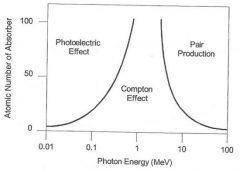
|
|
|
describe Compton scattering |
an incident photon with sufficient energy collides with an orbital electron knocking it from the atom creating a fast electron. The residual energy of the incident photon continues as a scattered photon of reduced energy.
Note, the 'hole' is filled when electrons of outer shells notice it releasing characteristic x-rays |
|
|
Production of free radicals is by ______ action |
indirect action produces free radicals that damage DNA |
|
|
An estimate _______ (fraction) of radiation damage is caused by the hydroxyl radical. |
2/3 |
|
|
List the chain of events that causes biological effects from radiation |
1. incident photon enters body 2. fast electron produced 3. Ion radical produced 4. Free radical created (decay) 5. bonds broken from reactivity of radical and DNA 6. biological effects |
|
|
In the LQ model what variables represent the repairable and non-repairable components |
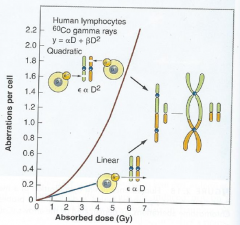
alpha = non-repairable
beta = repairable |
|
|
Neutrons create what secondary charged particles |
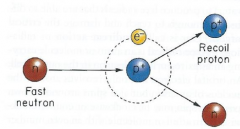
recoil protons |
|
|
The hydroxyl radical has a diffuse/reactivity potential of approx _________ |
4nm, DNA helix diameter = 2nm
double the width of the DNA molecule |
|
|
production of OH- radical. (chemical symbols) |
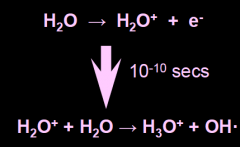
Note: OH- has one unpaired electron which makes its reactivity high |
|
|
Biological responses (3 and approx times) |
1. Cell kill ~hours/days
2. Oncogenic ~ months/years
3. Hereditary ~ generations |
|
|
Radiation chemist lingo:
'Spurs'-
'Blobs'- |
'spurs' - up to 100eV of energy (3 ion pairs, ~4nm diameter) (up to 95% of x/g ray depositions are spurs.
'blobs'- 100-500eV of energy (12 ion pairs, ~7nm diameter) |
|
|
How can DSBs be quantified? |
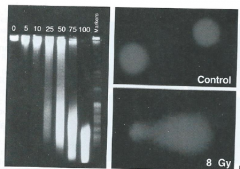
Quantification of DSB is done through pulse-field-gel-electrophoresis (PFGE)
*sugar phosphate has a net neg. charge*
|
|
|
List and briefly describe the cell stages/cycles |
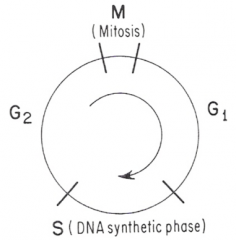
M = mitosis S= DNY syn. phase G= gaps |
|
|
Which cell stage/cycle has a drastically different time for mammals vs other. |
G1 cycle
ie. hamster cells t(G1)=1 HeLa cells t(G1)=11 |
|
|
What happens in the G1 and G2 phases |
G1 - 2 different pre-replication chromosomal strands not connected
G2 - post-replication chromosome in 'X' or 'Y' configuration |
|
|
Incorrect re-joining in which cell phase(s) is(are) responsible for chromosomal aberrations |
G1 and G2 |
|
|
List the lethal and non-lethal chromosomal aberrations |
Lethal - dicentrics, rings, anaphase bridges
Non-lethal - translocations, small deletions |
|
|
List one bio-marker for human radiation exposure |
T-lymphocytes (can detect down to 25cGy) |
|
|
key DNA repair pathways for DSBs |
-Homologous recombination repair (HRR) requires undamaged DNA strand as template occurs in late S/G2 phases Error free process
-Non-Homologous end joining (NHEJ) occurs in G1 phase prone to error, and source of oncogenic lesions |
|
|
Surviving fraction formula (LQ model) |

|
|
|
LQ model DSB vs SSB |
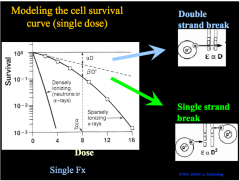
|
|
|
LQ model - at what does are the two components of cell kill equal |

|
|
|
Fractionation - Dose to reduce S to 37% etc |
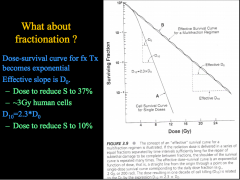
|
|
|
Single acute dose, surviving fraction as a function of the BED |

|
|
|
BED formula (excluding fractionation) |
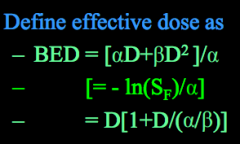
|
|
|
BED formula (including fractionation component) |
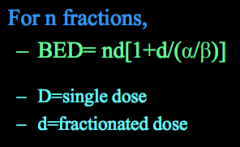
|
|
|
The LQ model is based on the probability of ______. |
The LQ model is based on the probability of 'DSBs'. |
|
|
4 R's of Radiobiology |
1) Repair of sublethal damage 2) Re-assortment of surviving cells within the cell cycle 3) Re-population of surviving cells 4) Re-oxygenation |
|
|
LQ model limitations |
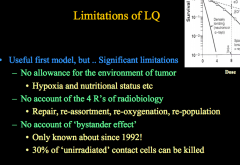
|
|
|
Neutrons interact with ________. |
Nucleii |
|
|
Fast neutrons have a KE > _____. They gradually _______ through ______ collisions with hydrogen atoms dominant. They create ______ which deposit energy at 30KeV/um. The max energy deposition (______) deposited by thermalised neutrons. |
KE > ~1MeV gradually thermalise through elastic collisions create recoil protons deposition (100keV/um) deposited |
|
|
Thermalized neutrons have a KE < ______. They have a _______ cross section for absorption with ____. They also release capture ______. |
KE < 1eV have a high cross absorption with H capture gammas |
|
|
Surviving fraction formula including the probability of DSBs |
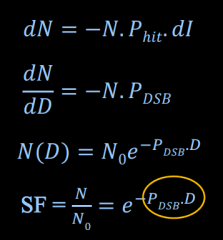
Note- The number of DSBs = Pdsb times D |
|
|
Two mechanisms responsible for DSBs |
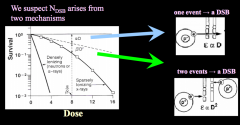
|
|
|
What ratio are tissues characterized by via the LQ model? |

|
|
|
LQ model limitations |

|
|
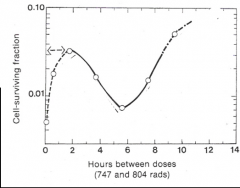
3 of the four R's of radiobiology as described by this graph |
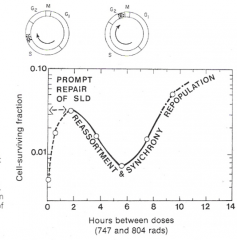
|
|
|
Cell cycle that varies drastically between HeLa cells and Hamster Cells. |

Time of the G1 phase! |
|
|
Progression through phases of the cell cycle are regulated by periodic activation of _______ |
The CDK family. Cyclin-dependent kinase. Various cyclin-dependent kinase-cyclin complexes are required to phosphylorate several protein substrates, which drive key events, including the initiation of DNA replication and the onset of mitosis. |
|
|
A group of cells' exposure to ___________ can cause their cycles to be made synchronous. This chemical does what??? |
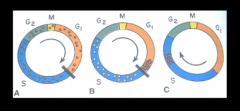
Hydroxy-urea
It kills cells in S and imposes a block at the end of G1 phase. |
|
|
Describe the molecular 'checkpoint' genes function and what the loss of this gene results in |
These genes stop the cell from cycling if it is damaged. Major checkpoint is in late G2.
Note: - Chromosome check/repair prior to mitosis - Loss of checkpoint leads to increased radio-sensitivity. |
|
|
DSBs can be repaired! But how? |
- Homologous recombination (S/G2) requires an undamaged template strand
- Non-homologous end joining (G1) error prone and may cause cancer mutations |
|

|
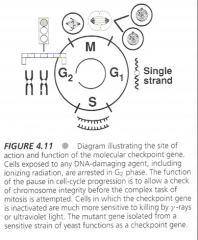
|
|
|
When are cells most sensitive?
When are cells most resistant? |
Sensitive: M phase, and often G2.
Resistant: slow cycling cells are resistant in early G1 and more sensitive in late G1. Greatest resistance in late S |
|
|
Effective repair of radiation damage mostly attributed by ___________ |
homologous repair (requires undamaged template strand) |
|
|
Sulfhydryls |
(natural radioprotectors)
Radiation resistance through the cell cycle correlates with the level of sulfhydryls. |
|
|
OER dependence on cell cycles |
The OER varies little with cell-cycle.
-Maybe slightly lower in G1 than S
|
|
|
Hereditary syndromes and radiation sensitivity |
some syndromes can result in high radiation sensitivity due to missing 'checkpoints'.
ie ataxia telangiectasia |
|
|
Dose Rate Effect |
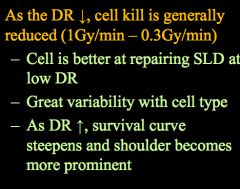
Note: Low DR < 50cGy/h |
|
|
Inverse-DR effect (concept) |
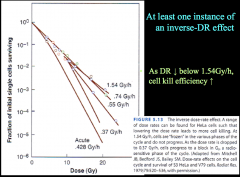
|
|
|
Inverse-DR effect (explanation) |
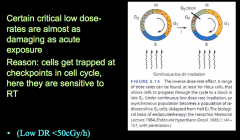
|
|
|
Repair half-time for sub-lethal damage to mamnalian cells is ~ _____
Clinically at least _____ between fractions |
1 hr
6 hrs |
|
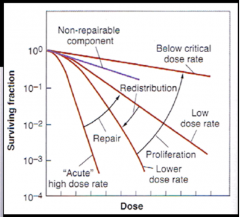
|
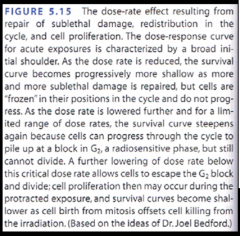
|
|
|
Oxygen enhancement ratio. Ratio of dose _______ / dose ___________ for same effect. OER can be as high as ____. OER goes _____ as LET goes up. |
Oxygen enhancement ratio. Ratio of dose hypoxic / does normoxic for same effect. OER can be as high a 3. OER goes down as LET goes up. |
|
|
OER vs LET |
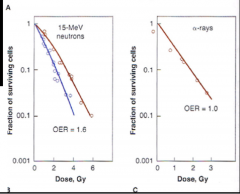
OER goes up as LET goes down. |
|
|
OER mechanisms |
2/3 of DNA damage is indirect
- when molecular O2 is present, free radiacl damage is 'fixed' (made permanent) -hypoxic cells, damage is repairable -fixation requires only ~3 mmHg or 0.5% O2 (normal level is ~ 50 mmHg) |
|
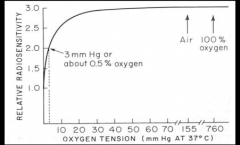
|
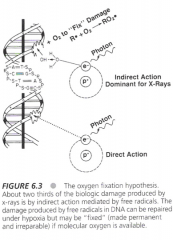
|
|
|
How does hypoxia manifest clinically? |
Hypoxia can be -Chronic - diffusion limited -Acute - temporary vessel closure
Hypoxia is associated with -increased risk of metastasis -genomic instability-selection of cells with diminished apoptotic potential |
|
|
Cells >~ ______ from 'functioning' vessels can become severely hypoxic. |
100 microns |
|
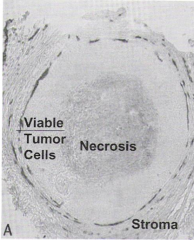
|
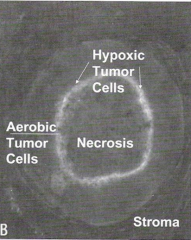
|
|
|
Hypoxic fraction in human tumors varies _____ to _____ %. Typically _____% |
0-50% Typically 15% |
|
|
Illustration of re-oxygenation |
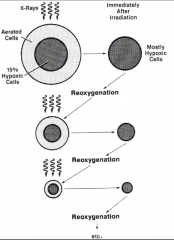
|
|
|
RBE formula
RBE and LET proportionality |

RBE - Relative Biological Effect |
|
|
Highest RBE value that is still efficient at causing DSBs |
Highest RBE is 100 KeV/micron. Higher RBE values become inefficient at causing DSBs |
|
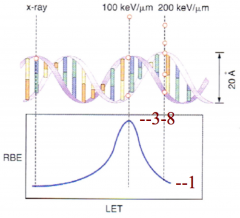
|
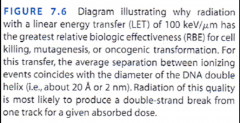
|
|
|
Does RBE vary with dose and fractionation |
Yes. RBE varies with dose and fractionation. |
|
|
RBE vs LET (plot) |
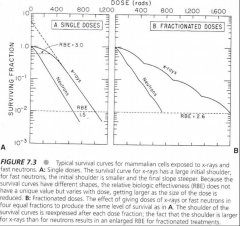
|
|
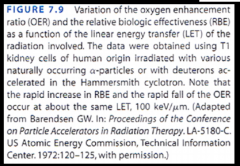
|
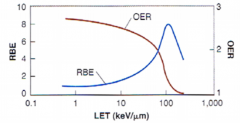
|

